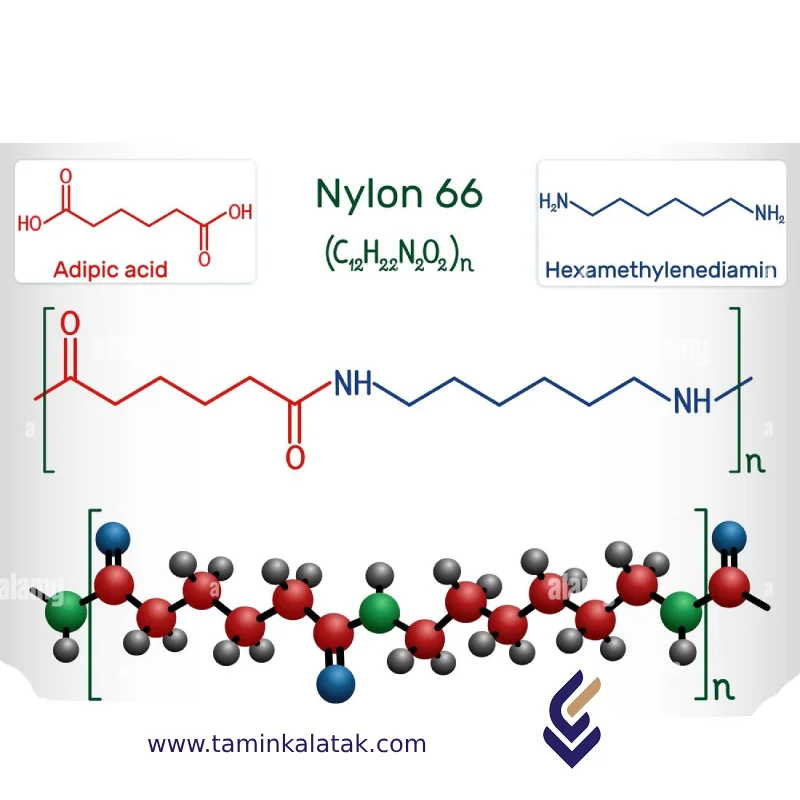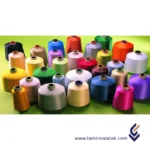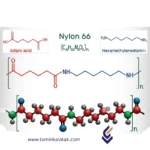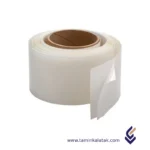Polymers are made up of very large molecules made up of many repeating units called monomers, which ultimately form this long polymer chain
Engineering polymers are high-performance plastics that exhibit superior mechanical, thermal, chemical, and electrical properties compared to standard commodity plastics.
Nylon 6-6
Nylon 66 is a type of synthetic polymer belonging to the nylon family of polyamides. It was first developed by Wallace Carothers and his team at DuPont in 1935. Nylon 66 is widely used due to its excellent mechanical properties, high thermal resistance, and chemical stability.
Structure
Nylon 66 is a synthetic polyamide with a repeating molecular structure formed through the condensation polymerization of hexamethylenediamine and adipic acid. The polymer consists of amide (-CONH-) linkages connecting alternating units of six carbon atoms from each monomer, resulting in a linear, highly ordered structure. This arrangement allows strong hydrogen bonding between polymer chains, enhancing its strength, rigidity, and thermal resistance. The repeating unit in Nylon 66 contains both aliphatic and amide groups, contributing to its balanced combination of flexibility and toughness. The presence of these intermolecular forces gives Nylon 66 its high melting point, excellent wear resistance, and mechanical stability, making it a widely used material in engineering and industrial applications.
Properties
Nylon 66 exhibits a combination of excellent mechanical, thermal, and chemical properties, making it highly suitable for various industrial applications. It has high tensile strength, toughness, and rigidity, which contribute to its durability and resistance to wear and abrasion. Its high melting point, typically around 255°C, allows it to maintain structural integrity under elevated temperatures. Nylon 66 also has good chemical resistance, particularly against oils, solvents, and many hydrocarbons, though it can absorb moisture, which may affect its mechanical properties. It has low friction and self-lubricating properties, making it ideal for applications requiring smooth movement and reduced wear. Additionally, Nylon 66 has good electrical insulation properties, making it useful in electrical and electronic components. Its ability to be easily molded and processed further enhances its versatility in manufacturing.
Applications of Nylon 66
- Automotive parts such as gears, bearings, fuel lines, and radiator tanks
- Electrical and electronic components like connectors, cable ties, and insulators
- Industrial machinery components, including conveyor belts and mechanical fasteners
- Textiles and fibers used in carpets, ropes, parachutes, and outdoor wear
- Consumer goods such as sports equipment, kitchen utensils, and zippers
- Packaging materials, especially in films and coatings for food and medical applications
Advantages of Nylon 66
- High tensile strength and durability
- Excellent resistance to wear, abrasion, and impact
- High melting point and good thermal stability
- Good chemical resistance to oils, solvents, and hydrocarbons
- Low friction and self-lubricating properties
- Good electrical insulation properties
- Easily moldable and processable for various applications
Disadvantages of Nylon 66
- Absorbs moisture, which can affect mechanical and dimensional stability
- Can degrade under prolonged exposure to UV light without proper additives
- More expensive than other types of nylon, such as Nylon 6
- Can be attacked by strong acids and bases
- High processing temperature required for manufacturing
Applications
| Applications | , , , , |
|---|
Nylon 6-6
| Products | Grade | Density(g/cm3) | Applications | Process method | Data Sheet | MSDS |
|---|---|---|---|---|---|---|
| Nylon 6-6 | Ertalon® 66 GF30 | 136,00 | Injection Molding Extrusion CNC Machining Compression Molding | |||
| Nylon 6-6 | Nylatron® 66 SA FR | 116,00 | njection Molding Extrusion CNC Machining | |||
| Nylon 6-6 | Nylatron® 66 SA FST | 114,00 | Injection Molding Extrusion CNC Machining |












